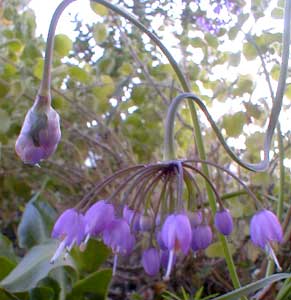
Nodding Wild Onion
"Behold her bend with maiden-braided brows
Above the wildflower, sidewise with its strain
Of dewy happiness."
-Madison Julius Cawein
(1865-1914)
(1865-1914)
Allium cernuum is called the "nodding" wild onion because of the little bend near the top of the leafeless stem, causing the blooms to turn downward, unlike the majority of extremely upright starburst onion-flowers. The species name refers in Latin to this nodding attribute.
This North American wildflower grows across the continent in much of the United States including Alaska & across Canada, including the whole of the Pacific Northwest, though not as far south as California. It is highly adaptable as to conditions from dry to damp, but in general it likes moist well-draining soil.
Although drought-hardy, it is not quite as as eager as many other alliums to never be watered. Its ideal would be prairie or meadow conditions which alternate seasonally wet spring & dry summer, & makes a good companion for widowgrass or camasia & similar prairie plants. Though in total a common wildflower, it has become rare in some areas of its range, & is listed as threatened in Iowa, Minnesota, & New York.
It prefers neutral to moderately alkaline soils, but adapts to our naturally acidic soils just fine, in conditions that are bright & sunny with perfect drainage. In Autumn we planted a mere three bulbs & its grass began to appear by late October, thin but sturdy through the winter, then really took off in mid to late spring.
It failed to bloom its first year perhaps because of excessive droughtiness in one of our tougher xeriscape gardens. But the following year it bloomed it repeated its previous pattern except that the bulbs continued to flourish into full flower in June, though depending on conditions nodding onions can bloom at any time from early summer to early autumn.
The grassy leaves become a foot tall unobtrusive slender clump, with the flowers rising a half-foot higher but on wiry stems that may tip lower. They are humble rather unobtrusive blossoms, very pretty when noticed but easily missed in a mixed bed.
The loose clusters or umbels of those nodding bell-flowers range from light pink to creamy white. Ours are a rich pinkish purple. The seedheads are still somewhat decorative in September when, if they are wanted, they can be harvested. It will naturalize by self-seeding as well as by bulb offsets.
All parts of the plant smell oniony if bruised. Though generally grown for ornamental value only, the bulbs in fact are reasonably tasty onions for stews, or the leaves make a good substitute for chives or as a soup flavoring.